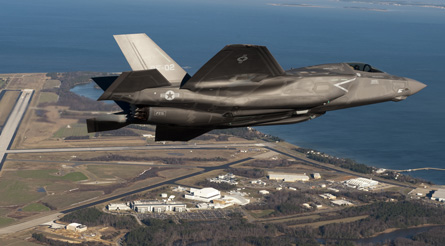A newly leaked document shows the Lockheed Martin F-35 test programme dropped even further behind schedule in fiscal year 2009, but the company insists it can still complete development in the "prescribed timeframe" in 2014.
The report by the director of operational test and evaluation (DOTE) concludes that Lockheed is struggling to deliver and fly Joint Strike Fighter test aircraft on time. The delays could extend the development phase until mid-2016, it says.
Lockheed delivered the first 10 of 13 system development and demonstration phase aircraft on time. The flying assets, meanwhile, seldom flew after delivery. The first two short take-off and vertical landing jets - BF-1 and BF-2 - completed just 16 of their planned 168 sorties in FY2009.
Schedule problems also surfaced with F-35 software, which requires more than 19 million lines of code for the aircraft and its logistics systems.
 |
|---|
© USAF |
The co-operative avionics testbed, or CATBird - a Boeing 737 modified into a flying laboratory - flew 55 times in FY2009, but cleared only seven of 284 test points, according to the DOTE report. How software stability deficiencies found during testing on Block 0.5 and 1.0 could change the overall schedule remains unknown, the report adds.
The DOTE staff also raised alarms about a series of obscure design change changes approved in FY2009 to save weight. After previously approving the removal of dry bay fire extinguishers, the joint programme office also eliminated shut-off fuses for engine fueldraulics lines. The combination increases the risk of combat losses because of fires caused by battle damage, the report says.
But the report also concedes that Lockheed has made progress in certain areas, particularly in structural testing. Structural loads testing up to 150% of limit load has apparently gone smoothly, with only doors and a blade seal requiring redesign. The STOVL aircraft entered flight-testing with 64% of their allowable envelope cleared. The programme's goal is to clear 80% of the envelope in static testing by mid-2011.
The DOTE report acknowledges that programme officials remain confident about the F-35's abilities. A recent internal assessment concludes that the F-35 is on track to be operationally effective, although it is expected to fall short on being reliable and cost-effective.
Moreover, Lockheed insists it is poised to make up for schedule delays faster than previous fighter development programmes. The F-35 programme has invested in a vast infrastructure of surrogate testbeds and simulation laboratories, it notes.
The DOTE report, however, notes that Lockheed's plan to show that its non-flying test venues are accredited has also fallen behind schedule.
Source: Flight International























